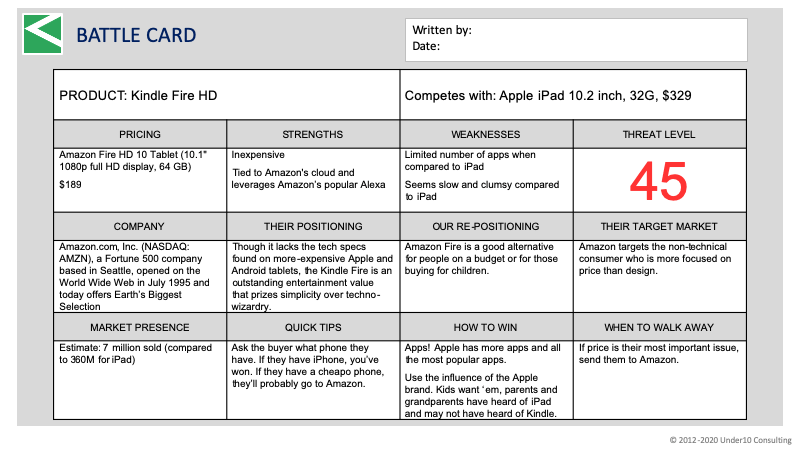Competitive Battle Cards
A key part of your product playbook is the competitive battle card or “kill” sheet. Sales people love these but, beware, battle cards can also come back to haunt you!

Product leaders and marketing managers learn a great deal about the competition as part of their daily interactions with customers and with sales people. The Competitive Battle Card is a digest of all you’ve learned... so your sales people are armed with the latest intel. The real challenge for those composing a battle card is not the formatting or the template but finding the right information to put into it. To compose a card, you’ll first need to have a folder filled with competitive information.
Here’s what goes in a battle card. It’s a summary of all you’ve learned about the competitor’s product. Or put another way, it’s all the critical information you can fit on a single page.

Most of this is self-explanatory. Company and product name. Pricing comparison. Strengths and weaknesses. Pretty standard stuff.
Re-positioning. The key to an effective battle card is re-positioning. Admit it: your competitor’s product has strengths! It might even be an appropriate choice for some customers. The trick is to reposition your competitor away from your ideal persona. In effect, you admit that their product is good... but only for specific uses.
For example, let’s say you make health information systems. If you were targeting large hospitals, you would reposition your competitors as appropriate for small implementations such as urgent medical care and small doctor groups. On the other hand, if your product is designed for consumers, then position the competitor as best for enterprises.
You can see how your competitive re-positioning strategy is closely linked to your own product and market strategy.
Weaknesses . Many product managers and sales people like to focus on competitive weaknesses but be careful: your competitors will fix their weaknesses someday. What they won’t do is change their product strengths or their operational approach. That’s why re-positioning your competitor is a much better approach that focusing on their product weaknesses.
Quick tips . Use this to explain how to quickly qualify or dis-qualify a potential customer. You can also use it for any critical information that doesn’t fit elsewhere.
How to win and when to walk away . Profile two kinds of customers: those who are ideal customers and those who are not ideal. Your own customer research (such as win/loss analysis) should reveal the conditions that are optimal for your product. If you don’t know your ideal buyer profile, you won’t be able to effectively re-position your competitor. Your sales team should focus on the ideal and walk away from the non-ideal customer profile.
Avoid trying to do all competitors at once. You think it’ll save time but it won’t. The information you need to share is altered, sometimes subtly, with each competitor. For example, you can’t easily compare Apple iPad, Kindle Fire and other readers in a single document. You’ll want to profile each against your offering.
Finding competitive information
How do you create a battle card? Read all the product information you can get your hands on.
Obviously, you’ll want to check out your competitor’s web site. You can certainly build a list of the key capabilities (as the competitor’s marketing team understands them) and you’ll often find pricing information. Remember: a web site shows the best of the product but doesn’t usually show the deep details that your sales people want.
Review your competitor’s media page to see what announcements they’ve made recently. You can often see where a product fits in the competitor’s strategic direction from what they say (or don’t say) in their announcements. If they announce recent “wins,” make a note of the companies; they’re a target for a competitive interview. Has an industry analyst, like Gartner or Forrester, written anything about them? Get your hands on that research note.
Search the world of social media too. You know the drill. What are people saying about your competitor? Twitter has become the venue for product complaints and you can learn a lot from customer complaints. LinkedIn offers many business-oriented groups focused on your product discipline; you’ll find information from people who are using the competitor's products. However, the information in social media is generally pretty thin.
Site-scraping and social media and analyst research notes can only tell you so much. You can use published information to familiarize yourself with the general product information shared by most companies. But what you’re really looking for is the names of people you can contact to dive deeper.
What’s the best competitive intelligence tool? Your phone.
Pick up the phone and call someone. Call a customer—after all, they probably looked at your competitor’s product when they were shopping for yours. Call a lost customer. Set up a phone discussion with the people you’ve been watching in social media. Get on the phone with your favorite industry analyst.
If interviewing customers is an area that’s new to you, let me recommend Roadmap to Revenue by Kristin Zhivago . She explains—step-by-step—how to conduct customer interviews. What questions to ask; the mechanics of setting up the call; how to share what you’ve learned with your team.
Also check out my free ebook on Customer Interviews .
Keep it internal
Battle cards are a great way to empower your sales teams. They summarize all you know about how to win deals against specific competitors. Sales people love ‘em—so much so that they’re likely to give a copy to their favorite clients and prospects.
For some sales people, “company confidential” is code for “distribute immediately.”
Years ago my company was acquired by our much larger competitor. The merger plan was to bring our two sets of products together into a unified family. At our first corporate get-together I met my counterpart, the one who managed the product that previously competed with mine. She said, “It’s such a delight to meet you; I’ve been reading your work for years.” She then showed me a folder that contained every confidential document I had ever shared with my sales people. She confessed that she usually received competitive information I’d published about her product the same day I distributed it to my sales people and generally republished it with her comments and retorts before that day was over!
You and I both know that sales people are inclined to share everything with clients. Keeping confidential information confidential is the single biggest challenge I faced as a product manager and as a marketing executive. On the one hand, you want to empower your sales people with the best competitive tools. On the other hand, you certainly don’t want that information shared with customers or competitors.
One rule to live by: don’t give anything to sales people that you don’t want your customers to see. Or your competitors. For example, don’t send a PowerPoint deck to your sales people unless you intend for them to send it—unmodified—to your customers, complete with all the instructor notes. And the same is true of competitor battle cards.
Only you can determine how much information you can safely share with your sales people.
For fun, do a quick search for your competitor's name plus "battlecard" or "confidential."


